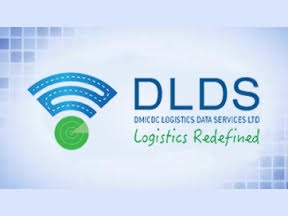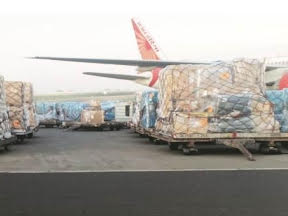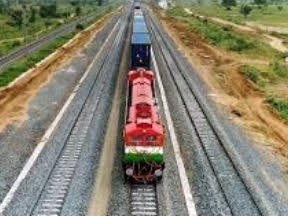The merchandise exports from Kerala stood at US$ 9.8 billion in 2018-19, as per the study published by the Export-Import Bank of India (Exim Bank). Despite exports from the state have registered robust growth during the recent period, there remains an untapped merchandise export potential of nearly US$ 6.7 billion. Realising this potential could increase merchandise exports from the state to nearly US$ 16.5 billion. With a favourable policy framework and concerted efforts to boost exports, Kerala could target to achieve US$ 54.7 billion of export revenues by 2024-25. Exim Bank released a working paper titled ‘Promoting Exports from Kerala: Insights and Policy Perspectives’. The study identifies a six-pronged export strategy for the state, built upon the essential dimensions of diversification of products and markets, infrastructure leverage and strengthening, capacity building, fiscal incentives, devising an export promotion campaign, and institutional streamlining. The Study recommends diversification away from traditional export items for Kerala towards higher value-added products such as processed food, technical textiles, bulk drugs, and electronics and machinery.
Read More »FFFAI launches online diploma course in logistics for shipping and freight forwarding
Through its training arm, Indian Institute of Freight Forwarders (IIFF), The Federation of Freight Forwarders’ Associations in India (FFFAI) has announced the launch of Online Diploma Course in Logistics/ Shipping and Freight Forwarding. This is the only course that is validated by the International Freight Forwarding Association, FIATA which has a worldwide acceptability and recognition. According to Tej Contractor, President, IIFF, “This is a great opportunity for all the logistics service providers to enrol their next generation leaders to sharpen the skills of the existing workforce and most importantly to provide a stepping stone to the wide opportunities in the Logistics Sector for aspirants who wish to make their mark. He further pointed out that logistics is one of the fastest growing sectors today. The FIATA validated diploma course would open up-growth opportunities and provide an edge for the candidates in the field of customs broking, shipping & freight forwarding, multimodal transportation and many more. “Our faculties are industry experts enriched with vast knowledge and decades of experience in all the specialised fields of logistics. Candidates may gain independence by up-scaling their skill sets with our ‘Independence Enrolment Offer’ with a 50 per cent discount to all those who register in the early bird offer commencing from August 15, 2020 till August 31, 2020,” he underscored. He also informed that from September 1, 2020, the regular course fee will be ₹35,000 + GST @ 18 per cent. The course is scheduled to commence in September 2020. Interested candidates may fill up the details by clicking on https://forms.gle/QAZ6whGUbTphwcQn8.
Read More »From the pages of CargoTalk: It’s difficult for asset heavy companies to survive the rising diesel price: Chander Agarwal
Sharing his views on continuous hike in diesel price, Chander Agarwal, Managing Director, TCI Express, informs, “Most of the logistics companies in India are asset heavy. These companies cannot survive due to the increasing diesel price. They can have growth of 60-70 per cent but their bottom line will be 40 per cent. And, imagine 95 per cent of the unorganised economy is having heavy losses; how they are going to continue providing services? The government has to get a hold on this.” Suggesting the solution, he continued, “One important way of doing that could be if there is a change in diesel price, the manufacturing companies which are using the transportation services should be made liable to pay for that change. If the government imposes this on manufacturing companies, a large chunk of the unorganised segment will not face a massive cash crunch and they will be able to survive longer.”
Read More »Tata Motors introduces 16-wheeeler tipper truck to move coal & construction aggregates
Tata Motors has announced the launch of country’s first 16-wheeler, 47.5-tonne multi-axle tipper truck, named Signa 4825.TK, for surface transport of coal and construction aggregates. The Signa 4825.TK’s gross vehicle weight allows more load per trip with its 29 cubic metre box load body. The truck offers enhanced performance, higher payload capacity, lower total cost of ownership, higher comfort and safety for the driver. The tipper truck is equipped with 3 distinct drive modes – light, medium and heavy – to ensure optimum power and torque selection, based on the load and terrain, ensuring high fuel efficiency. It comes as a factory-built, ready-to-use vehicle with the 29 cubic metre tipper body and hydraulics. The Signa 4825.TK is available in two configurations: 10×4, 10×2 to offer flexibility to the customer, basis their requirement. RT Wasan, Vice President, Product Line, M&HCV, Tata Motors, said, “Recognising the needs of the customers such as those in construction and coal industry who wish to complete large projects ahead of time, we have developed India’s largest tipper, with gross vehicle weight of 47.5 tonnes. It has been our constant endeavour to deliver the best product offerings that match and excel the country’s evolving needs and demands. Through our Power of 6 philosophy, we will continue to offer first-in-the-industry products and solutions and further strengthen our position in the cargo and Construck segments.”
Read More »DLDS upgrades Logistics Data Bank portal with detailed end-to-end tracking
To enhance its customers’ experience and mitigate risks in the current challenging times, DMICDC Logistic Data Services (DLDS) has revamped Logistics Data Bank (LDB) portal. The redesigned LDB portal brings in a well-defined layout and navigation and delivers a visually pleasing platform to its customers. The portal now provides detailed voyage tracking of EXIM containers with end-to-end tracking map view. Earlier the information was provided only for next destination but now detailed information can be accessed about container port of loading and unloading. International location tracking plays a huge part in planning supply chain, and now imported containers can be tracked from the port of loading. Users can do multiple container tracking and group container tracking through a grid console to enable user-friendly engagement. “We did a lot of brainstorming to see how we could help shape the portal and information to better suit those who need it the most. LDB users can now see dwell time of containers at Ports, CFSs, ICDs on a real-time basis. We have also added the feature of gate cut off and expected vessel departure information to enable our customers to plan their daily operations efficiently,” said Surajit Sarkar, COO, DLDS. Speaking about the project update Mr. Ichiro Oshima, CEO DLDS said, “The new portal is designed to empower our customers to mitigate risks in the current challenging times. The interactive map with DPE/DPD and next delivery information will make it easier for users to plan and monitor their operations.”
Read More »Bengaluru Airport records 79% growth in cargo movement
Kempegowda International Airport, Bengaluru (KIAB/BLR Airport) facilitated shipment of ~71,406 Metric Tonnes (MT) of cargo including 6,194 MT of perishables and 2,300 MT of pharma supplies between April and July 2020. During this period, BLR Airport’s cargo market share rose to 15.3 per cent from 11.2 per cent. While international cargo throughput was 51,728 MT, domestic was 19,678 MT during this period. Of this, perishables, including 507 MT of mangos, were delivered to 31 international destinations. Apart from perishables and pharma, the other freight processed during this period included electronic and engineering equipment, spares and readymade garments. Before the pandemic, airport’s cargo volumes were distributed between freighter and passenger aircraft in 40:60 ratios. However, the lockdown and subsequent restrictions on international scheduled passenger flights, impacted cargo movements. Several airlines commenced ‘cargo-only’ flights using passenger aircraft to bolster depressed global airfreight capacity and drive a spike in cargo demand. About 40 per cent of BLR Airport’s cargo during the period April to July 2020, was transported by Passenger-to-Cargo (PTC: Passenger flights ferrying cargo) aircraft. As a result, BLR Airport recorded more than 2,990 Cargo ATMs, registering a 79% growth over the same period last year. In addition, BLR Airport processed 341 MT of COVID-19-related cargo from March to July.
Read More »From the pages of CargoTalk: Technology, no less than a business driver: Amar More
Highlighting the kinds of technologies required navigating through this pandemic, Amar More, CEO, Kale Logistics Solutions, said, “Going back to pre-COVID and post-COVID, to understand that how can the industry be safer and more efficient, we have to understand the behaviour of the virus. This virus spreads through paper and social interaction.” He added that one has to consider the following facts. • The virus stays on paper for three to four days, thus, we have a war on paper. We have to strongly consider how we can eliminate paper in today’s age when electronic data can be moved. Hence, first we have to ponder on any technology that eliminates paper. • Secondly, the virus can be stopped with social distancing so anything that causes congestion is damaging. Our air cargo complexes, around peak time, are crowded with many people at the terminal, at the documentation counter or queue of trucks; that also doesn’t help social distancing. So, technologies that can reduce congestion are very important.
Read More »LATAM Cargo introduces Miami-Florianopolis route to its schedule
LATAM Cargo has launched a weekly service from Miami, US, to Florianopolis using a Boeing 767F aircraft with a 53-tonne capacity. Brazilian exports carried on the route include automotive, metallurgical, food, pharmaceutical and electronic products, among others. The route connects North America with Southern Brazil, as well as offering wider connections to Europe and Asia. Gabriel Oliva, Commercial Vice President — North America, Europe and Asia, LATAM Cargo, says, “This new route will allow us to provide a direct, stable and permanent service between the US and Santa Catarina. As strategic partners, we are constantly evaluating routes that promote international trade, bringing buyers and sellers together with the characteristic speed, attention and logistics excellence of our global services network.” “We will continue to be focused on offering more origins-destinations for our international and domestic markets in order to be present in our clients’ relevant markets,” adds Kamal Hadad, Vice President of Alliances and Network, LATAM Cargo, Before the Miami-Florianopolis route was implemented, international cargo entered Brazil through Guarulhos and Viracopos. Hence, it depended on complementary ground transportation in order to reach its final destination.
Read More »Mundra Port becomes largest container handling port; handles 968,000 TEUs in Q1
Adani Ports and Special Economic Zone (APSEZ) recorded 26.33 per cent decline in consolidated profit to Rs 757.83 crore for April to June quarter due to COVID-19-induced lockdowns. The company had registered a consolidated net profit of Rs 1,028.69 crore in the corresponding period a year earlier. Despite the fall in cargo volumes, Mundra port became the largest container handling port in India by handling 0.97 million TEUs in Q1 FY21, surpassing JNPT volume of 0.85 million. Lockdown measures to tame the spread of COVID-19 resulted in lower import and export, impacting cargo throughput in first quarter of FY21. Its total income declined to Rs 2,749.46 crore for the first quarter, as against Rs 3,216.92 crore in the year-ago period. The company’s total expenses during the quarter under review rose to Rs 1,805.24 crore as compared to Rs 1,796.34 crore in the year-ago period. “In the first quarter of FY21, we were able to perform operationally at par with pre-COVID levels. During this period, we relooked at fundamentals of port operations and realigned costs, thus maintaining Port EBIDTA (earnings before interest, taxes, depreciation, and amortisation) margin of 70 per cent,” says, Karan Adani, Chief Executive Officer and Whole Time Director, APSEZ. The company said there has been a steady increase in cargo throughput across the ports from July 2020. During July 2020, APSEZ handled cargo volume of 18.30 MMT, a growth of 6 per cent on year-on-year basis and 31 per cent over June 2020. “This trend gives us confidence that worst is behind us and going forward cargo volume in FY21 is expected to stabilise. Shift from road to rail and increase in services enabled Adani Logistics to achieve …
Read More »Andhra Government calls for dedicated freight corridor connectivity to its ports
With an aim to transport millions of tonnes of cargo in a cost-effective manner, the Andhra Pradesh government has requested the Railways to extend its dedicated freight corridor to ports in the state. Mentioning how significant the freight-only corridors could become for goods transport, NP Ramakrishna Reddy, CEO, Andhra Pradesh Maritime Board wrote to the Dedicated Freight Corporation of India Limited (DFCCIL), requesting its support in the state’s upcoming port development projects. He said the DFC connectivity will act as a catalyst for the overall development of the ports and ensure effective and pollution-free transportation of the cargo, besides being cost-effective. “For this purpose, MoU may be entered into to ensure better coordinated efforts,” he said in the letter, dated August 10. The DFCCIL is presently working on two corridors; Western Corridor and the Eastern Corridor. Four other corridors are proposed. In his letter, Reddy told the DFCCIL that handling of cargoes at all the non-major ports, already developed or under development, in the state is to be done either by road or rail. He said the existing ports have rail links, but DFC connectivity will catalyse the overall development of the ports.
Read More » Cargo Breaking News
Cargo Breaking News









